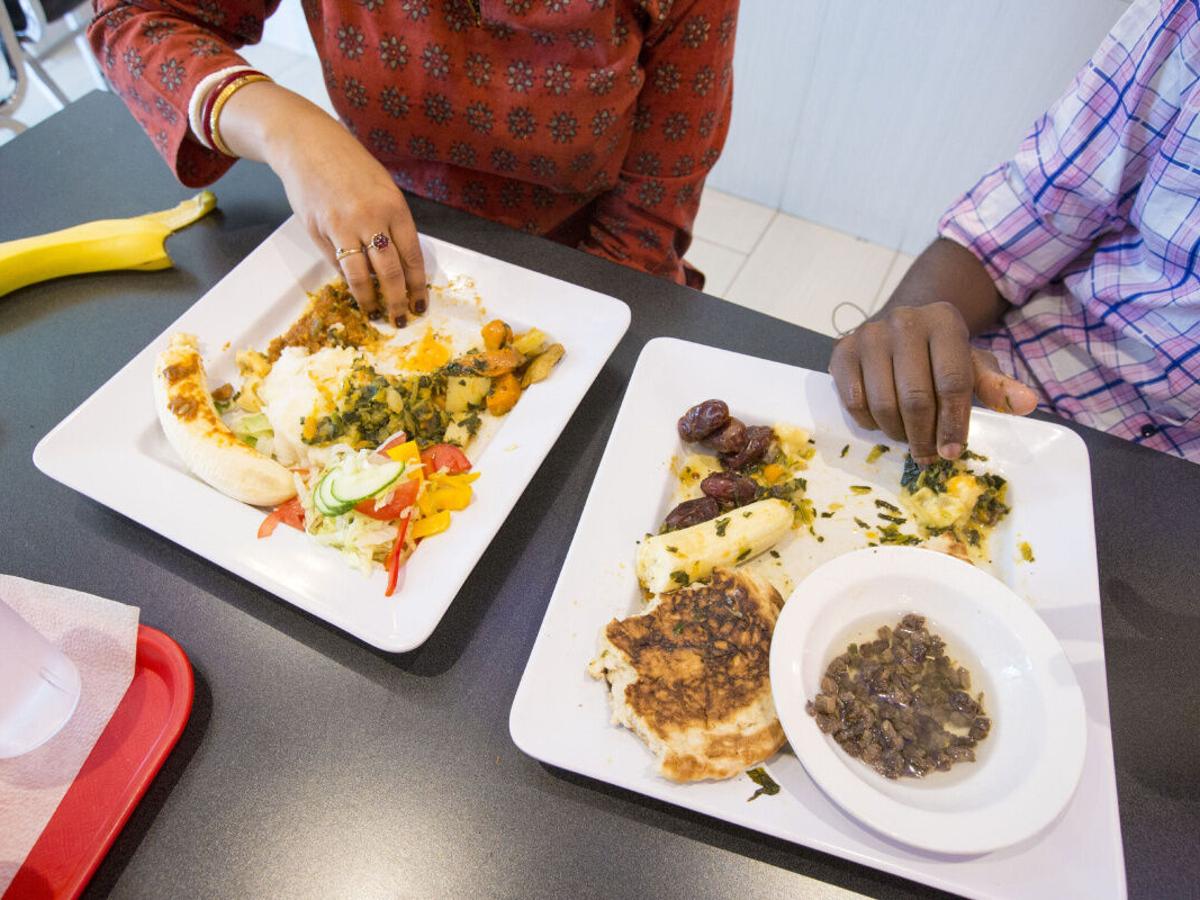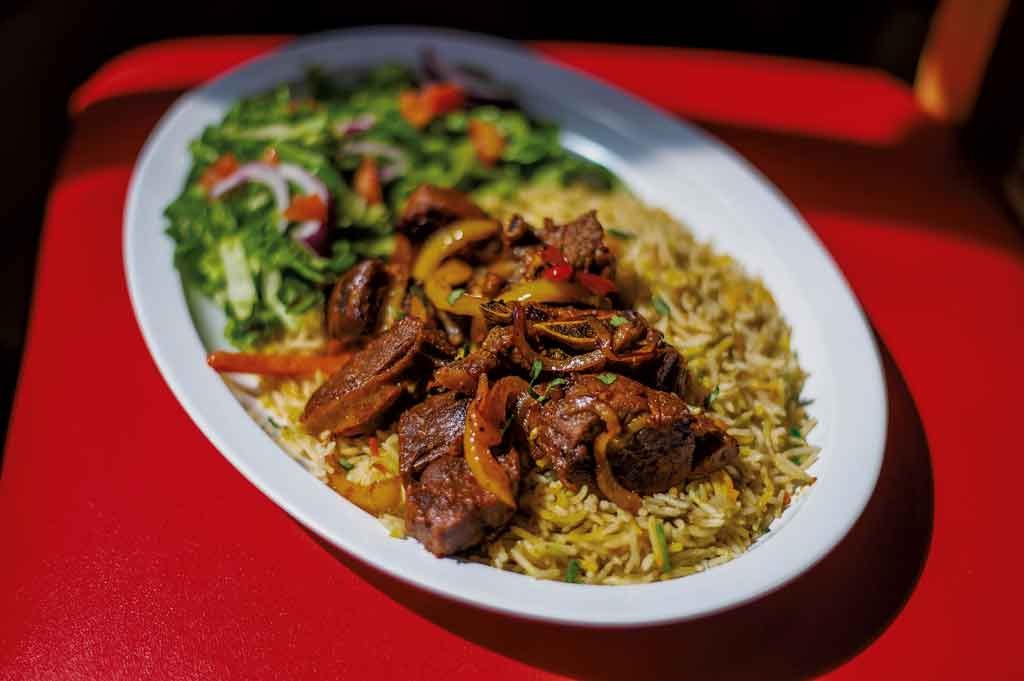Somali Food Revealed: Delight In Authentic Tastes and Ageless Dishes
Wiki Article
Relishing the Unique Preferences and Flavors of Somali Gastronomy: a Trip With the Land of Spices and Saffron

Aromatic Spices and Saffron
Initially, let's check out the abundant variety of aromatic seasonings and saffron that will take your taste on a journey with Somali gastronomy. Somali food is recognized for its bold and savory dishes, which are accomplished through the proficient use fragrant seasonings. From cumin and coriander to cardamom and cinnamon, Somali food boasts a broad variety of spices that include deepness and intricacy to its meals. These fragrant flavors are made use of in both standard and modern Somali dishes, producing an one-of-a-kind and unforgettable taste account.One of the most treasured flavors in Somali cuisine is saffron. Understood for its vivid color and distinct fragrance, saffron is typically used to raise and boost the tastes of Somali recipes. Whether it's sprayed on rice pilaf, instilled in hot tea, or made use of in curries and stews, saffron includes a touch of luxury to Somali gastronomy.
In enhancement to their culinary relevance, these aromatic flavors and saffron also hold cultural importance in Somali food. They are used in conventional parties and gatherings, representing warmth, hospitality, and the richness of Somali culture.
Standard Somali Meals
Discover the delectable variety of standard Somali meals that will certainly transport you to a world of strong flavors and cultural splendor. Somali food is a delightful fusion of African, Center Eastern, and Indian influences, resulting in an one-of-a-kind cooking experience. One renowned recipe is the Somali rice, understood as "Bariis." Great smelling basmati rice is cooked with aromatic spices, such as cardamom, cinnamon, and cloves, giving it a cozy and welcoming aroma. Another must-try recipe is "Suqaar," a stir-fry of softened meat or poultry, onions, garlic, and an assortment of flavors. The meat is cooked up until it is succulent and breaking with flavor. For those seeking a vegan alternative, "Iskudhehkaris" is a wonderful choice. This recipe includes a combination of potatoes, carrots, peas, and rice, cooked in a savory tomato-based sauce. Somali cuisine additionally flaunts tasty flatbreads, such as "Canjeero" and "Injera," which are ideal for scooping up stews and sauces. No Somali dish is total without a mug of spiced tea, recognized as "Shaah." It is made with black tea leaves, cardamom coverings, cinnamon sticks, and a touch of cloves, creating a cozy and comforting drink. Begin on a culinary journey and enjoy the varied and rich tastes of typical Somali meals.Influences From Arab and Indian Cuisine
Immerse yourself in the vibrant flavors of Somali gastronomy as you find the abundant impacts from Arab and Indian food. Somali food has been formed by centuries of profession and social exchange with Arab and Indian sellers. These influences can be seen in the diverse spices, tastes, and cooking methods utilized in Somali recipes.Arab cuisine has had a considerable influence on Somali gastronomy. Somali meals typically include active ingredients such as cardamom, cinnamon, cloves, and saffron that are frequently made use of in Arab food preparation. The usage of these seasonings adds deepness and complexity to Somali dishes, creating a distinct taste profile.
Indian food has actually also left its mark on Somali gastronomy. Somali dishes commonly incorporate flavors such as turmeric, cumin, and coriander, which are generally made use of in Indian cooking. These spices not just add taste but additionally provide Somali recipes their vivid colors. The usage of turmeric gives Somali rice recipes a brilliant yellow hue.
Along with spices, Arab and Indian cooking techniques have likewise influenced Somali cooking. The idea of slow-moving food preparation or seasoning meat in flavors before grilling, called "maraq," is believed to have originated from Arab cuisine. The use of flatbreads, like "canjeero," which is comparable to Indian dosa, can be mapped back to Indian cooking practices.
The impacts from Arab and Indian cuisine have actually added depth and complexity to Somali gastronomy. These impacts have not just shaped the active ingredients and flavors used in Somali recipes yet have actually also added to the social identity of Somali food. As you begin on your culinary journey via Somali gastronomy, be prepared to appreciate the distinct preferences and flavors that have been influenced by Arab and Indian food.

Exploring Regional Flavors
As you look into the varied cooking landscape of Somali gastronomy, a plethora of regional tastes awaits your taste buds. Each area in Somalia flaunts its very own distinct ingredients, cooking strategies, and flavor mixes that include deepness and selection to the country's cuisine.In the northern region of Somalia, you will certainly discover flavors influenced by the nomadic way of living and distance to the Gulf of Aden. Below, camel meat takes spotlight, prepared in a variety of ways, including marination in a selection of flavors and slow-cooking. The usage of dried fruits, such as figs and days, enhances the splendor of dishes, while the coastal influence brings an abundance of fish and shellfish to the table.
In the main area, the food is defined by passionate recipes that mirror the farming heritage of the area. Millet and sorghum are staple grains, used to make breads like injera and canjeero. Stews made with goat meat, vegetables, and fragrant Click Here flavors like cumin and coriander are usual and provide a ruptured of tastes.
Moving towards the southern region, you will experience a combination of flavors affected by the Bantu individuals and the Indian Sea profession courses. Coconut milk, exotic fruits, and aromatic spices like cardamom and cloves are used freely in meals, producing a distinct and lively preference profile.
Exploring local tastes in Somali gastronomy permits you to experience the diverse social influences that have actually shaped the nation's cuisine. From the nomadic tastes of the north to the agricultural heartiness of the main region and the seaside combination of the south, each bite narrates of practice, heritage, and the vivid tapestry of Somali gastronomy.
Exquisite Desserts and Beverages
Enjoy the tantalizing flavors of Somali gastronomy via a wonderful selection of treats and beverages that showcase the abundant social heritage of the country. Somali desserts are a true joy for the detects, offering an ideal blend of sweet taste and exotic flavors. One preferred treat is Kac Kac, a deep-fried pastry made with flour, cardamom, and sugar. Its crunchy appearance and aromatic scent make it a favored amongst locals and visitors alike. An additional significant treat is Malawax, a thin, pancake-like pastry that can be taken pleasure in simple or with a variety of garnishes such as jam, honey, or butter. Its light and cosy texture makes it an ideal treat for at any time of the day.When it concerns beverages, Somali food uses a rejuvenating choice of beverages that match the tastes of the desserts. A must-try is Shaah, a traditional spiced tea made with black tea leaves, cardamom, cloves, and cinnamon. The aromatic blend of flavors develops a reassuring and cozy drink that is typically taken pleasure in with a side of biscuits or dates. For an extra cooling option, Somali individuals enjoy Qaxwo, a revitalizing yogurt-based drink seasoned with fruits such as banana, strawberry, or mango. Its velvety and tangy preference supplies a best equilibrium to the sweet taste of the desserts (Somali food).
Verdict
So next time you're in the mood to discover new flavors and seasonings, make certain to add Somali gastronomy to your checklist. From the fragrant flavors and saffron to the traditional meals affected by Arab and Indian foods, there is something delicious and special for everybody to appreciate.From fragrant seasonings to conventional dishes affected by Arab and Indian food, Somali gastronomy is a delightful fusion of tastes. These impacts can be seen in the varied flavors, tastes, and cooking strategies used in Somali meals.

These flavors not just add flavor but also provide Somali recipes their vivid colors (Somali food). These influences have not just formed the flavors and components utilized in Somali meals however have additionally added to the social identification of Somali cuisine
Report this wiki page